THE new Pan Asian restaurant at the ITC Grand Maratha Sheraton in Bombay has introduced the Korean barbecue, the Chinese hotpot and the Japanese yakitori grill for the first time to this food-crazy city. Chef Gev Desai, who rules the ITC roost in Bombay, told me about the restaurant: �It has six major cuisines, count them, there�s Chinese, Thai, Japanese, Mongolian, Korean, and a spattering of what is popularly known as Indo-Malaysian food. We have also introduced the Mongolian brazier and the Chinese shinjiang roaster. This is otherwise known as the duck oven. We do Peking Duck in it. Come, let me show you.�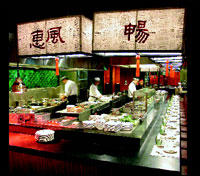 He is a silent but forceful worker, this Chef Desai. Quietly he marched me to the shinjiang roaster and threw it open for my benefit. Unfortunately, there was no Peking Duck baking at that time. But Chef Liang, who is the Grand Maratha�s import from the ITC Maurya Sheraton in New Delhi, and who is from Beijing and therefore the Peking Duck expert, came hurrying along to see what was happening. �Duck,� said Chef Desai sorrowfully, �which is such an essential part of Oriental cuisine, is almost impossible to get in Bombay.� The restaurant�s need is 80 ducks per month. And the demand cannot be catered to. �We are ready to import the duck, but there is so much of red tape involved, that I decided to get it from Delhi and Pune.� Fortunately, Chef Liang�s preparation of Peking Duck has not suffered with the main product being sourced locally.
He is a silent but forceful worker, this Chef Desai. Quietly he marched me to the shinjiang roaster and threw it open for my benefit. Unfortunately, there was no Peking Duck baking at that time. But Chef Liang, who is the Grand Maratha�s import from the ITC Maurya Sheraton in New Delhi, and who is from Beijing and therefore the Peking Duck expert, came hurrying along to see what was happening. �Duck,� said Chef Desai sorrowfully, �which is such an essential part of Oriental cuisine, is almost impossible to get in Bombay.� The restaurant�s need is 80 ducks per month. And the demand cannot be catered to. �We are ready to import the duck, but there is so much of red tape involved, that I decided to get it from Delhi and Pune.� Fortunately, Chef Liang�s preparation of Peking Duck has not suffered with the main product being sourced locally.
�The Chinese expats,� this chef told me in a funny sing-song manner, �just want Peking Duck all the time.�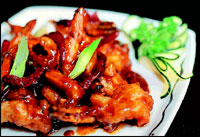 But let me start at the beginning. The Pan Asian is the Grand Maratha�s eighth restaurant and the third in the series at ITC Welcomgroup Hotels. They have Pan Asian restaurants in Delhi and Kolkata as well. I believe it was the idea of Chairman Habib Rehman to start such a multi-cuisine restaurant. He is one of New Delhi�s greatest foodies and the story goes that Habib Rehman knows the complete menus of the ITC Hotels� Dum Pukht, Bukhara and Dakshin restaurants backwards. I don�t know how far it is true. And whether to this amazing repertoire, he has now added the vast menu of six cuisines from the Pan Asian restaurants as well. But he is certainly credited with being the inspiration, if not the brain, behind the Pan Asian restaurants.
But let me start at the beginning. The Pan Asian is the Grand Maratha�s eighth restaurant and the third in the series at ITC Welcomgroup Hotels. They have Pan Asian restaurants in Delhi and Kolkata as well. I believe it was the idea of Chairman Habib Rehman to start such a multi-cuisine restaurant. He is one of New Delhi�s greatest foodies and the story goes that Habib Rehman knows the complete menus of the ITC Hotels� Dum Pukht, Bukhara and Dakshin restaurants backwards. I don�t know how far it is true. And whether to this amazing repertoire, he has now added the vast menu of six cuisines from the Pan Asian restaurants as well. But he is certainly credited with being the inspiration, if not the brain, behind the Pan Asian restaurants. 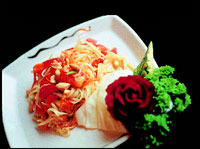 The brain, of course, is Chef Desai and his two expat chefs: Chef Liang, who was formerly the Chinese master chef at the Great Wall Sheraton Hotel in Beijing; and, Chef Lertanong Pudpong who comes from the Sheraton Laguna Beach Hotel in Phuket. Chef Desai said to me, �Habib Rehman�s instruction was to go beyond Chinese and Thai. The idea behind Pan Asian was to mix several cuisines in one restaurant. We have tried to be as authentic as possible. The Bombay Pan Asian is offering 70 per cent of the product you can get at Delhi and Kolkata. Delhi does not have the Korean barbecue and Chinese hotpot. And Kolkata has the exclusive teppanyaki grill. We don�t have that. All three Pan Asian restaurants have the Mongolian brazier. But Bombay is the only restaurant with the shinjiang roaster. We are already charged by the feedback the restaurant has got since it opened in July.�
The brain, of course, is Chef Desai and his two expat chefs: Chef Liang, who was formerly the Chinese master chef at the Great Wall Sheraton Hotel in Beijing; and, Chef Lertanong Pudpong who comes from the Sheraton Laguna Beach Hotel in Phuket. Chef Desai said to me, �Habib Rehman�s instruction was to go beyond Chinese and Thai. The idea behind Pan Asian was to mix several cuisines in one restaurant. We have tried to be as authentic as possible. The Bombay Pan Asian is offering 70 per cent of the product you can get at Delhi and Kolkata. Delhi does not have the Korean barbecue and Chinese hotpot. And Kolkata has the exclusive teppanyaki grill. We don�t have that. All three Pan Asian restaurants have the Mongolian brazier. But Bombay is the only restaurant with the shinjiang roaster. We are already charged by the feedback the restaurant has got since it opened in July.�
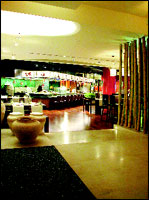 I will not describe the restaurant in great detail to you, because discovering the Pan Asian if you are a serious foodie, is half the fun of eating out there. I would have imagined that putting together the menu for such a restaurant must have been the most difficult part of setting up the Pan Asian. Chef Desai agreed. �But we took our core competencies and put them to work,� he explained. �Whoever knew anything of these six cuisines, we got them on our team. There was Chef Liang who knew 50 items of food! And Chef Lertanong who could do the Thai food. I knew something of Korean food having studied the cuisine at the Galbi House Restaurant at Sheraton Walker Hill Hotel in Seoul and explored the small barbecue eating houses in that city�s railway stations, markets and other places. And we had another Indian chef with some expertise at Japanese food.�
I will not describe the restaurant in great detail to you, because discovering the Pan Asian if you are a serious foodie, is half the fun of eating out there. I would have imagined that putting together the menu for such a restaurant must have been the most difficult part of setting up the Pan Asian. Chef Desai agreed. �But we took our core competencies and put them to work,� he explained. �Whoever knew anything of these six cuisines, we got them on our team. There was Chef Liang who knew 50 items of food! And Chef Lertanong who could do the Thai food. I knew something of Korean food having studied the cuisine at the Galbi House Restaurant at Sheraton Walker Hill Hotel in Seoul and explored the small barbecue eating houses in that city�s railway stations, markets and other places. And we had another Indian chef with some expertise at Japanese food.�
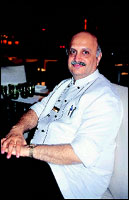 So they started mixing and matching cuisines to prepare the Pan Asian�s menu, aware, all the time, that they would have to satisfy the Indian diners of Bombay and the 30, 40 expats who visited the Grand Maratha Sheraton every day and who would expect their kind of food at the restaurant. �What the expats eat, the Indians would not touch, and what the Indians like to have for dinner, the expats would not consider at all,� Chef Desai explained. They settled on a judicious mix of what was authentic and what people would like to eat, giving reasonable attention to seafood, and quietly opened the Pan Asian one evening. The response was phenomenal. �These are initial months, we are waiting and watching, and once the product cements itself, we will even consider changing the menu every four, five months,� Chef Desai announced confidently.
So they started mixing and matching cuisines to prepare the Pan Asian�s menu, aware, all the time, that they would have to satisfy the Indian diners of Bombay and the 30, 40 expats who visited the Grand Maratha Sheraton every day and who would expect their kind of food at the restaurant. �What the expats eat, the Indians would not touch, and what the Indians like to have for dinner, the expats would not consider at all,� Chef Desai explained. They settled on a judicious mix of what was authentic and what people would like to eat, giving reasonable attention to seafood, and quietly opened the Pan Asian one evening. The response was phenomenal. �These are initial months, we are waiting and watching, and once the product cements itself, we will even consider changing the menu every four, five months,� Chef Desai announced confidently.
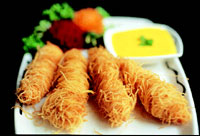 Let me attempt to describe the restaurant to you. Its interiors are supposed to reflect the spirit of Asia. I suppose that�s what the Oriental coloured walls and pillars, the Chinese paper lamps, urns and bamboo shoots mean. This was all done in-house, by an ITC Hotels project team, and its creative head is a whiz by the name of Franchesca Basu. The restaurant�s service staff is equipped with Motorola wireless communication devices to coordinate the food pick-ups from the five delivery points and bar and get them together at the table. �Other restaurants have show kitchens within them,� Chef Desai said, �we have the restaurant within kitchens! To get, say, 12 diners� orders from five different kitchens simultaneously and hot to the table is quite a feat!�
Let me attempt to describe the restaurant to you. Its interiors are supposed to reflect the spirit of Asia. I suppose that�s what the Oriental coloured walls and pillars, the Chinese paper lamps, urns and bamboo shoots mean. This was all done in-house, by an ITC Hotels project team, and its creative head is a whiz by the name of Franchesca Basu. The restaurant�s service staff is equipped with Motorola wireless communication devices to coordinate the food pick-ups from the five delivery points and bar and get them together at the table. �Other restaurants have show kitchens within them,� Chef Desai said, �we have the restaurant within kitchens! To get, say, 12 diners� orders from five different kitchens simultaneously and hot to the table is quite a feat!�
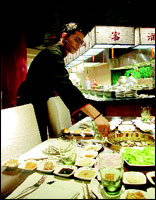 I agree. And having said that, I will try to run you through the menus of the six cuisines briefly. You must go there and find out the Pan Asian for yourself. I warn you, this won�t be possible in one or even two or three outings. Go with the intention of enjoying every experience there, and you will. From the Chinese and Thai stir-fry and wok kitchen, ask Chef Liang to recreate some of his homeland specialities using the shinjiang roaster. His barbecued spare ribs, crispy chicken Cantonese style and Gua Tai (pan-seared lamb dumplings) are to die for. Or stick to the delicately cut meats and fresh vegetables tossed on a super-high flame to enhance flavour and colour in the wok. The Mongolian brazier is a heavy metal hot plate on which the chef attending to you grills meats, seafoods, vegetables with seasonings and sauces at your table.
I agree. And having said that, I will try to run you through the menus of the six cuisines briefly. You must go there and find out the Pan Asian for yourself. I warn you, this won�t be possible in one or even two or three outings. Go with the intention of enjoying every experience there, and you will. From the Chinese and Thai stir-fry and wok kitchen, ask Chef Liang to recreate some of his homeland specialities using the shinjiang roaster. His barbecued spare ribs, crispy chicken Cantonese style and Gua Tai (pan-seared lamb dumplings) are to die for. Or stick to the delicately cut meats and fresh vegetables tossed on a super-high flame to enhance flavour and colour in the wok. The Mongolian brazier is a heavy metal hot plate on which the chef attending to you grills meats, seafoods, vegetables with seasonings and sauces at your table.
The Japanese section with its yakitori and teppanyaki styles of preparation concentrates on grilled salmon, chicken mince balls and Malay chicken satays on skewers made of moist bamboo. The yakitori is a national passion in Japan. And the teppanyaki station with its flat stainless steel grill has evolved into a performing art form. It does Japan�s batayaki (grilling with butter) featuring Atsu Age (deep-fried crispy tofu in soy ginger sauce). However, the piece de resistance of the restaurant is undoubtedly the Korean barbecue and hot pot. No other restaurant in Bombay has this. And for this alone, you must make a visit to the Pan Asian from wherever you are situated. I will describe it to you in more detail than the other cooking stations.
The Korean tables have the barbecue in-built and are especially designed to grill seafood and meat and have it with kimchi, sticky rice and dipping sauces. In Korea, they do 500 kimchis, at the Pan Asian there are five. These are whole raddish, grated raddish, cabbage, cabbage stuffed with raddish, and cucumber. The hot pot is meant for leisure family dining. It is a soupy meal in which a cauldron of boiling stock sits simmering on the grill on your table and into this you feed slices of meat, seafood and vegetables. The ingredients cook immediately. To this you also add noodles and then, after two or three minutes, you ladle yourself a bowlful of the hot pot and add to it from the dipping sauces placed on your table. The first time you have Korean hot pot, a
chef will lead you through it. After you get the hang of it, do it yourself, it is great fun.
The Pan Asian Restaurant
ITC Grand Maratha Sheraton & Towers,
Sahar, Bombay 400 099.
Telephone: 2830 3030.
|





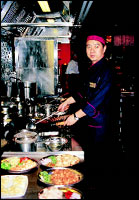 The Pan Asian restaurant at the ITC Grand Maratha Sheraton in Bombay makes eating out truly an international experience, discovers MARK MANUEL.
The Pan Asian restaurant at the ITC Grand Maratha Sheraton in Bombay makes eating out truly an international experience, discovers MARK MANUEL.
 He is a silent but forceful worker, this Chef Desai. Quietly he marched me to the shinjiang roaster and threw it open for my benefit. Unfortunately, there was no Peking Duck baking at that time. But Chef Liang, who is the Grand Maratha�s import from the ITC Maurya Sheraton in New Delhi, and who is from Beijing and therefore the Peking Duck expert, came hurrying along to see what was happening. �Duck,� said Chef Desai sorrowfully, �which is such an essential part of Oriental cuisine, is almost impossible to get in Bombay.� The restaurant�s need is 80 ducks per month. And the demand cannot be catered to. �We are ready to import the duck, but there is so much of red tape involved, that I decided to get it from Delhi and Pune.� Fortunately, Chef Liang�s preparation of Peking Duck has not suffered with the main product being sourced locally.
He is a silent but forceful worker, this Chef Desai. Quietly he marched me to the shinjiang roaster and threw it open for my benefit. Unfortunately, there was no Peking Duck baking at that time. But Chef Liang, who is the Grand Maratha�s import from the ITC Maurya Sheraton in New Delhi, and who is from Beijing and therefore the Peking Duck expert, came hurrying along to see what was happening. �Duck,� said Chef Desai sorrowfully, �which is such an essential part of Oriental cuisine, is almost impossible to get in Bombay.� The restaurant�s need is 80 ducks per month. And the demand cannot be catered to. �We are ready to import the duck, but there is so much of red tape involved, that I decided to get it from Delhi and Pune.� Fortunately, Chef Liang�s preparation of Peking Duck has not suffered with the main product being sourced locally. But let me start at the beginning. The Pan Asian is the Grand Maratha�s eighth restaurant and the third in the series at ITC Welcomgroup Hotels. They have Pan Asian restaurants in Delhi and Kolkata as well. I believe it was the idea of Chairman Habib Rehman to start such a multi-cuisine restaurant. He is one of New Delhi�s greatest foodies and the story goes that Habib Rehman knows the complete menus of the ITC Hotels� Dum Pukht, Bukhara and Dakshin restaurants backwards. I don�t know how far it is true. And whether to this amazing repertoire, he has now added the vast menu of six cuisines from the Pan Asian restaurants as well. But he is certainly credited with being the inspiration, if not the brain, behind the Pan Asian restaurants.
But let me start at the beginning. The Pan Asian is the Grand Maratha�s eighth restaurant and the third in the series at ITC Welcomgroup Hotels. They have Pan Asian restaurants in Delhi and Kolkata as well. I believe it was the idea of Chairman Habib Rehman to start such a multi-cuisine restaurant. He is one of New Delhi�s greatest foodies and the story goes that Habib Rehman knows the complete menus of the ITC Hotels� Dum Pukht, Bukhara and Dakshin restaurants backwards. I don�t know how far it is true. And whether to this amazing repertoire, he has now added the vast menu of six cuisines from the Pan Asian restaurants as well. But he is certainly credited with being the inspiration, if not the brain, behind the Pan Asian restaurants. The brain, of course, is Chef Desai and his two expat chefs: Chef Liang, who was formerly the Chinese master chef at the Great Wall Sheraton Hotel in Beijing; and, Chef Lertanong Pudpong who comes from the Sheraton Laguna Beach Hotel in Phuket. Chef Desai said to me, �Habib Rehman�s instruction was to go beyond Chinese and Thai. The idea behind Pan Asian was to mix several cuisines in one restaurant. We have tried to be as authentic as possible. The Bombay Pan Asian is offering 70 per cent of the product you can get at Delhi and Kolkata. Delhi does not have the Korean barbecue and Chinese hotpot. And Kolkata has the exclusive teppanyaki grill. We don�t have that. All three Pan Asian restaurants have the Mongolian brazier. But Bombay is the only restaurant with the shinjiang roaster. We are already charged by the feedback the restaurant has got since it opened in July.�
The brain, of course, is Chef Desai and his two expat chefs: Chef Liang, who was formerly the Chinese master chef at the Great Wall Sheraton Hotel in Beijing; and, Chef Lertanong Pudpong who comes from the Sheraton Laguna Beach Hotel in Phuket. Chef Desai said to me, �Habib Rehman�s instruction was to go beyond Chinese and Thai. The idea behind Pan Asian was to mix several cuisines in one restaurant. We have tried to be as authentic as possible. The Bombay Pan Asian is offering 70 per cent of the product you can get at Delhi and Kolkata. Delhi does not have the Korean barbecue and Chinese hotpot. And Kolkata has the exclusive teppanyaki grill. We don�t have that. All three Pan Asian restaurants have the Mongolian brazier. But Bombay is the only restaurant with the shinjiang roaster. We are already charged by the feedback the restaurant has got since it opened in July.� I will not describe the restaurant in great detail to you, because discovering the Pan Asian if you are a serious foodie, is half the fun of eating out there. I would have imagined that putting together the menu for such a restaurant must have been the most difficult part of setting up the Pan Asian. Chef Desai agreed. �But we took our core competencies and put them to work,� he explained. �Whoever knew anything of these six cuisines, we got them on our team. There was Chef Liang who knew 50 items of food! And Chef Lertanong who could do the Thai food. I knew something of Korean food having studied the cuisine at the Galbi House Restaurant at Sheraton Walker Hill Hotel in Seoul and explored the small barbecue eating houses in that city�s railway stations, markets and other places. And we had another Indian chef with some expertise at Japanese food.�
I will not describe the restaurant in great detail to you, because discovering the Pan Asian if you are a serious foodie, is half the fun of eating out there. I would have imagined that putting together the menu for such a restaurant must have been the most difficult part of setting up the Pan Asian. Chef Desai agreed. �But we took our core competencies and put them to work,� he explained. �Whoever knew anything of these six cuisines, we got them on our team. There was Chef Liang who knew 50 items of food! And Chef Lertanong who could do the Thai food. I knew something of Korean food having studied the cuisine at the Galbi House Restaurant at Sheraton Walker Hill Hotel in Seoul and explored the small barbecue eating houses in that city�s railway stations, markets and other places. And we had another Indian chef with some expertise at Japanese food.� So they started mixing and matching cuisines to prepare the Pan Asian�s menu, aware, all the time, that they would have to satisfy the Indian diners of Bombay and the 30, 40 expats who visited the Grand Maratha Sheraton every day and who would expect their kind of food at the restaurant. �What the expats eat, the Indians would not touch, and what the Indians like to have for dinner, the expats would not consider at all,� Chef Desai explained. They settled on a judicious mix of what was authentic and what people would like to eat, giving reasonable attention to seafood, and quietly opened the Pan Asian one evening. The response was phenomenal. �These are initial months, we are waiting and watching, and once the product cements itself, we will even consider changing the menu every four, five months,� Chef Desai announced confidently.
So they started mixing and matching cuisines to prepare the Pan Asian�s menu, aware, all the time, that they would have to satisfy the Indian diners of Bombay and the 30, 40 expats who visited the Grand Maratha Sheraton every day and who would expect their kind of food at the restaurant. �What the expats eat, the Indians would not touch, and what the Indians like to have for dinner, the expats would not consider at all,� Chef Desai explained. They settled on a judicious mix of what was authentic and what people would like to eat, giving reasonable attention to seafood, and quietly opened the Pan Asian one evening. The response was phenomenal. �These are initial months, we are waiting and watching, and once the product cements itself, we will even consider changing the menu every four, five months,� Chef Desai announced confidently. Let me attempt to describe the restaurant to you. Its interiors are supposed to reflect the spirit of Asia. I suppose that�s what the Oriental coloured walls and pillars, the Chinese paper lamps, urns and bamboo shoots mean. This was all done in-house, by an ITC Hotels project team, and its creative head is a whiz by the name of Franchesca Basu. The restaurant�s service staff is equipped with Motorola wireless communication devices to coordinate the food pick-ups from the five delivery points and bar and get them together at the table. �Other restaurants have show kitchens within them,� Chef Desai said, �we have the restaurant within kitchens! To get, say, 12 diners� orders from five different kitchens simultaneously and hot to the table is quite a feat!�
Let me attempt to describe the restaurant to you. Its interiors are supposed to reflect the spirit of Asia. I suppose that�s what the Oriental coloured walls and pillars, the Chinese paper lamps, urns and bamboo shoots mean. This was all done in-house, by an ITC Hotels project team, and its creative head is a whiz by the name of Franchesca Basu. The restaurant�s service staff is equipped with Motorola wireless communication devices to coordinate the food pick-ups from the five delivery points and bar and get them together at the table. �Other restaurants have show kitchens within them,� Chef Desai said, �we have the restaurant within kitchens! To get, say, 12 diners� orders from five different kitchens simultaneously and hot to the table is quite a feat!� I agree. And having said that, I will try to run you through the menus of the six cuisines briefly. You must go there and find out the Pan Asian for yourself. I warn you, this won�t be possible in one or even two or three outings. Go with the intention of enjoying every experience there, and you will. From the Chinese and Thai stir-fry and wok kitchen, ask Chef Liang to recreate some of his homeland specialities using the shinjiang roaster. His barbecued spare ribs, crispy chicken Cantonese style and Gua Tai (pan-seared lamb dumplings) are to die for. Or stick to the delicately cut meats and fresh vegetables tossed on a super-high flame to enhance flavour and colour in the wok. The Mongolian brazier is a heavy metal hot plate on which the chef attending to you grills meats, seafoods, vegetables with seasonings and sauces at your table.
I agree. And having said that, I will try to run you through the menus of the six cuisines briefly. You must go there and find out the Pan Asian for yourself. I warn you, this won�t be possible in one or even two or three outings. Go with the intention of enjoying every experience there, and you will. From the Chinese and Thai stir-fry and wok kitchen, ask Chef Liang to recreate some of his homeland specialities using the shinjiang roaster. His barbecued spare ribs, crispy chicken Cantonese style and Gua Tai (pan-seared lamb dumplings) are to die for. Or stick to the delicately cut meats and fresh vegetables tossed on a super-high flame to enhance flavour and colour in the wok. The Mongolian brazier is a heavy metal hot plate on which the chef attending to you grills meats, seafoods, vegetables with seasonings and sauces at your table.